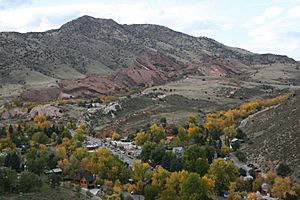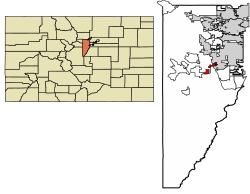Morrison, Colorado facts for kids
Quick facts for kids
Morrison, Colorado
|
|
|---|---|

Town of Morrison with Red Rocks Amphitheatre in background
|
|
| Motto(s):
The Nearest Faraway Place
|
|

Location of Morrison in Jefferson County, Colorado
|
|
| Country | |
| State | |
| County | Jefferson County |
| Incorporated | January 29, 1906 |
| Government | |
| • Type | Home rule municipality |
| Area | |
| • Total | 4.24 km2 (2.2 sq mi) |
| • Land | 4.23 km2 (2.2 sq mi) |
| • Water | 0.01 km2 (0.00 sq mi) |
| Elevation | 1,941 m (6,368 ft) |
| Population
(2020)
|
|
| • Total | 396 |
| • Density | 93.40/km2 (180/sq mi) |
| Time zone | UTC-7 (MST) |
| • Summer (DST) | UTC-6 (MDT) |
| ZIP code |
80465
|
| Area code(s) | Both 303 and 720 |
| FIPS code | 08-52075 |
| GNIS feature ID | 2413014 |
Morrison is a small town in Jefferson County, Colorado, United States. It's known as a "home rule municipality," which means it has the power to govern itself locally. In 2020, about 396 people lived here.
Contents
Exploring Morrison's Past
Morrison is a town with a rich history, especially linked to a man named George Morrison. He was a builder and businessman who came to the area in 1859.
George Morrison: Town Founder
George Morrison, who came from Canada, was a skilled stonemason. He helped start the town of Mt. Vernon. He also built the Mt. Vernon House, an important stop for travelers. This house was on the toll road from Denver to the goldfields.
Later, George Morrison moved to Bear Creek. There, he started the Morrison Stone, Lime, and Town Co. In 1874, he planned out the town that we now call Morrison. He also helped bring the Denver, South Park and Pacific Railroad to Morrison in 1874.
Building with Stone
As a quarryman, George Morrison found and developed building stone in the Morrison area. This stone became famous for its high quality. Many buildings in Morrison and Denver were made from this special red sandstone. For example, parts of the Brown Palace Hotel and Union Station in Denver use stone from Morrison.
Some of the buildings George Morrison built in Morrison are still standing today. The Cliff House, built in 1873, was his family home and now offers guest lodging. The Morrison Schoolhouse, built in 1875, served the town's kids until 1955. These buildings show George Morrison's important contributions to the area's history.
Mount Morrison is also named after him.
Discovering Ancient Dinosaurs
The area around Morrison is famous for its dinosaur discoveries. In the late 1800s, a layer of rock called the Morrison Formation was named after the town. This rock layer is about 150 million years old! It's known for being the first place where three famous dinosaurs were found: Apatosaurus, Diplodocus, and the Colorado state fossil, Stegosaurus.
The Morrison Formation stretches across many western states. It has taught us a lot about the ancient animals that lived there long ago.
Famous Dinosaur Finds
In 1877, Arthur Lakes found the first Stegosaurus armatus and Apatosaurus ajax fossils near Morrison. Most of these fossils were sent to Othniel Charles Marsh at Yale University. These discoveries were part of the "Bone Wars," a rivalry between paleontologists Marsh and Edward Drinker Cope.
Today, you can visit the Morrison Natural History Museum to see some of these fossils. Museum staff are even re-exploring Lakes' original dig sites. They have found rare Stegosaurus tracks, including those of baby Stegosaurus!
You can also see Cretaceous-age dinosaur tracks and one of Lakes' historic dig sites at Dinosaur Ridge, just east of Morrison.
Morrison in the 20th Century
The town of Morrison officially became a town on January 9, 1906. The first mayor was Thomas Cowan Morrison, who was George Morrison's son. The town's first leaders worked to set up rules and manage the town.
Pete Morrison, George Morrison's grandson, became a famous cowboy actor in early silent films. He even had his own movie studio in Hollywood!
In 1976, the historic parts of Morrison were added to the National Register of Historic Places. This means they are recognized as important historical sites.
Where is Morrison Located?
Morrison is southwest of Denver, Colorado. It covers about 2.2 square miles of land. The town is located near State Highway 470 and Morrison Road.
The Morrison postal ZIP code (80465) covers a larger area than just the town itself. This means many people and events linked to "Morrison" might actually be in nearby areas of Jefferson County.
How Many People Live Here?
The number of people living in Morrison has changed over the years. Here's a look at the population counts from different years:
| Historical population | |||
|---|---|---|---|
| Census | Pop. | %± | |
| 1880 | 186 | — | |
| 1890 | 254 | 36.6% | |
| 1910 | 251 | — | |
| 1920 | 195 | −22.3% | |
| 1930 | 177 | −9.2% | |
| 1940 | 216 | 22.0% | |
| 1950 | 306 | 41.7% | |
| 1960 | 426 | 39.2% | |
| 1970 | 439 | 3.1% | |
| 1980 | 478 | 8.9% | |
| 1990 | 465 | −2.7% | |
| 2000 | 430 | −7.5% | |
| 2010 | 428 | −0.5% | |
| 2020 | 396 | −7.5% | |
| U.S. Decennial Census | |||
Famous People from Morrison
Some well-known people have connections to Morrison, Colorado:
- Pete Morrison, a silent film actor
- Trey Parker, who helped create the TV show South Park
- Patrick Park, a folk singer
See also
 In Spanish: Morrison (Colorado) para niños
In Spanish: Morrison (Colorado) para niños

